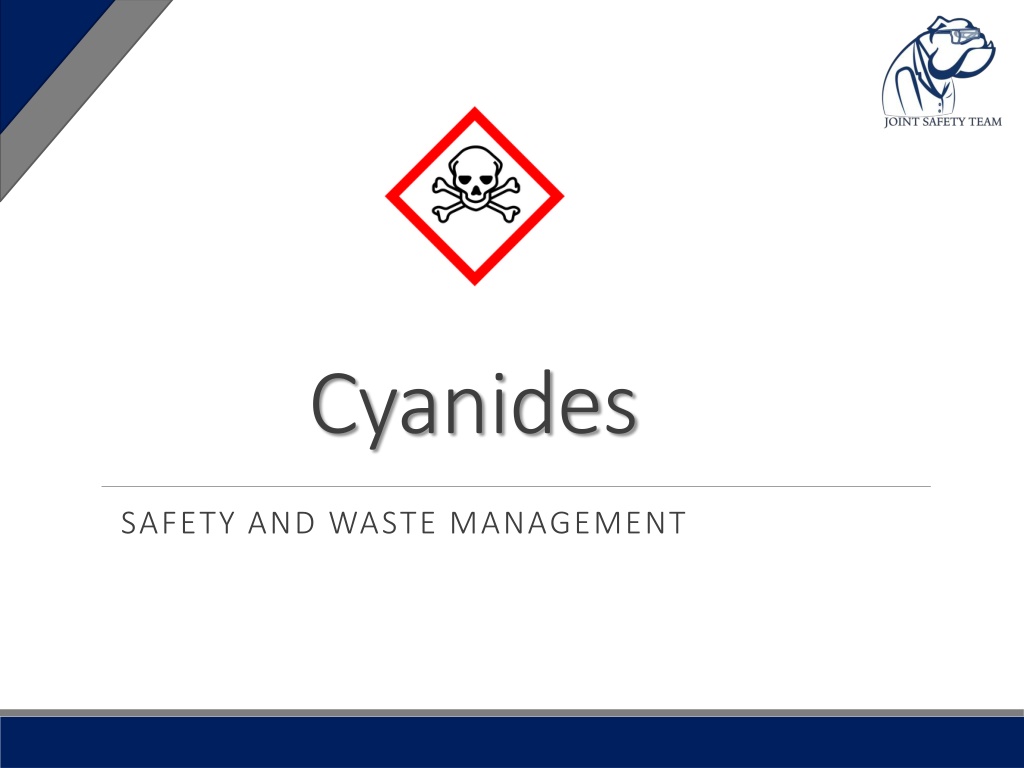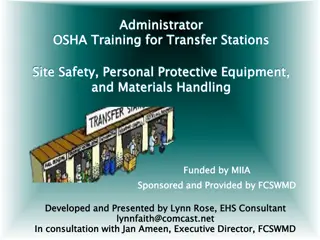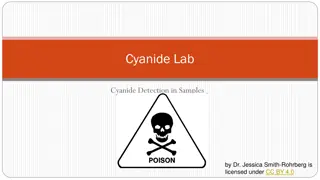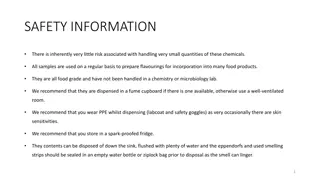Cyanide Safety and Handling Guidelines
Cyanide compounds pose serious health risks if mishandled, requiring strict safety protocols for storage, usage, and disposal. Understanding cyanide toxicity, symptoms of exposure, and appropriate emergency responses is crucial to prevent fatality. Proper handling measures, including protective gear, designated work areas, and waste management procedures, ensure worker safety and environmental protection. Additional focus on treatment methods, such as the use of hydroxocobalamin antidote, highlights the importance of swift action in cyanide poisoning cases.
Download Presentation

Please find below an Image/Link to download the presentation.
The content on the website is provided AS IS for your information and personal use only. It may not be sold, licensed, or shared on other websites without obtaining consent from the author.If you encounter any issues during the download, it is possible that the publisher has removed the file from their server.
You are allowed to download the files provided on this website for personal or commercial use, subject to the condition that they are used lawfully. All files are the property of their respective owners.
The content on the website is provided AS IS for your information and personal use only. It may not be sold, licensed, or shared on other websites without obtaining consent from the author.
E N D
Presentation Transcript
Cyanides SAFETY AND WASTE MANAGEMENT
HCN producing materials Benzyl cyanides (phenylacetonitrile) Readily hydrolyzed under acidic conditions (restricted) Found in plant sources cyanogenic glycosides Cyanide Salts: HCN pka~ 11 KCN, NaCN, LiCN, MgCN2, CuCN, AgCN, NR4CN, ZnCN2 Incompatible with all acids and strong oxidants Stored in a dry place away from other materials. Cyanogens (CN)2undergoes reduction to cyanide Volatile cyanogen bromide (Br-CN) undergoes substitution with water. Decomposition of ferricyanides and ferrocyanides Water, acids, over time 6 HCl + K3[Fe(CN)6] 6 HCN + FeCl3+ 3 KCl Combustion under O2 deficiency Plastics derived from PAN - synthetic wool/furs and fabrics, carbon fibers.
Cyanide Toxicity Cyanide salts such as KCN are hydrolyzed to HCN by stomach acid. LD50= 3-8 mg/Kg Blood concentration: >3 mg/L death (~15 mg). Cyanide inhibits cytochrome oxidase enzyme preventing cells from using oxygen Exposure Symptoms: dizziness, headache, nausea and vomiting, rapid heart rate and breathing. Low blood pressure Fatality cause by loss of consciousness and respiratory failure followed by convulsions. ~40% of people can smell the bitter almond scent of cyanide Compound Interest: http://www.compoundchem.com/2015/02/26/cyanide/
Response and Treatment Speed is critical. Avoid mouth-to-mouth resuscitation and contact with vomit. Supplemental O2 to prevent histotoxic hypoxia. Cyanide has a short half life and is converted to thiocyanate in the body. Not much can be done to detect cyanide poising in time. Hydroxocobalamin (Cyanokit) antidote is administered by a medical professional via IV and converts cyanide to harmless cyanocobalamin. Antidotes are in short supply do to abuse of amyl nitrite, short shelf lives, slow reaction time, route of administration, and high cost.
Safe Handling, Cleanup, and Disposal Transport cyanides in a secondary container Use, weigh and workup exclusively in the hood Wear a mask if massing solids outside the hood Double glove when handling and change gloves after clean-up. Workup reactions with a basic solution; pH 10+ solution Do not quench with acids, water/brine, concentration on the rotovap etc. no matter what the procedure says. Use basic dilute bleach (~10%) for cleaning contaminated materials and equipment. KCN +NaOCl KOCN +NaCl Waste and empty reagent bottles must be disposed of separately as hazardous waste. Leave for pick up do not dispose with regular garbage or recycling Collect all cyanides from cleaning, workup solutions and solid waste in a plastic bottle with a highly basic solution of KOH.























